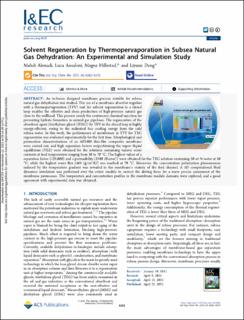| dc.contributor.author | Ahmadi, Mahdi | |
| dc.contributor.author | Ansaloni, Luca | |
| dc.contributor.author | Hillestad, Magne | |
| dc.contributor.author | Deng, Liyuan | |
| dc.date.accessioned | 2021-11-16T09:52:18Z | |
| dc.date.available | 2021-11-16T09:52:18Z | |
| dc.date.created | 2021-04-27T16:41:43Z | |
| dc.date.issued | 2021 | |
| dc.identifier.citation | Industrial & Engineering Chemistry Research. 2021, 60 6262-6276. | en_US |
| dc.identifier.issn | 0888-5885 | |
| dc.identifier.uri | https://hdl.handle.net/11250/2829782 | |
| dc.description.abstract | An in-house designed membrane process suitable for subsea natural gas dehydration was studied. The use of a membrane absorber together with a thermopervaporation (TPV) unit for solvent regeneration in a closed loop enables the effective and clean production of high-pressure natural gas close to the wellhead. This process avoids the continuous chemical injection for preventing hydrate formation in natural gas pipelines. The regeneration of the absorbent agent (triethylene glycol (TEG)) by TPV in the closed loop is highly energy-efficient, owing to the unlimited free cooling energy from the cold subsea water. In this work, the performance of membranes in TPV for TEG regeneration was evaluated experimentally for the first time. Morphological and permeation characterizations of an AF2400 thin-film composite membrane were carried out, and high separation factors outperforming the vapor–liquid equilibrium (VLE) were obtained for the solutions containing various water contents at feed temperatures ranging from 30 to 70 °C. The highest values of a separation factor (128,000) and a permeability (2380 (Barrer)) were obtained for the TEG solution containing 30 wt % water at 30 °C, while the highest water flux (468 (g/m2·h)) was reached at 70 °C. Moreover, the concentration polarization phenomenon induced by the temperature gradient was revealed in the membrane’s vicinity of the feed channel. A 3D computational fluid dynamics simulation was performed over the entire module to correct the driving force for a more precise assessment of the membrane permeance. The temperature and concentration profiles in the membrane module domains were explored, and a good agreement with experimental data was obtained. | en_US |
| dc.language.iso | eng | en_US |
| dc.publisher | American Chemical Society | en_US |
| dc.rights | Navngivelse 4.0 Internasjonal | * |
| dc.rights.uri | http://creativecommons.org/licenses/by/4.0/deed.no | * |
| dc.title | Solvent Regeneration by Thermopervaporation in Subsea Natural Gas Dehydration: An Experimental and Simulation Study | en_US |
| dc.type | Peer reviewed | en_US |
| dc.type | Journal article | en_US |
| dc.description.version | publishedVersion | en_US |
| dc.source.pagenumber | 6262-6276 | en_US |
| dc.source.volume | 60 | en_US |
| dc.source.journal | Industrial & Engineering Chemistry Research | en_US |
| dc.identifier.doi | 10.1021/acs.iecr.1c00266 | |
| dc.identifier.cristin | 1906765 | |
| dc.relation.project | Norges forskningsråd: 237893 | en_US |
| cristin.ispublished | true | |
| cristin.fulltext | original | |
| cristin.qualitycode | 2 | |

